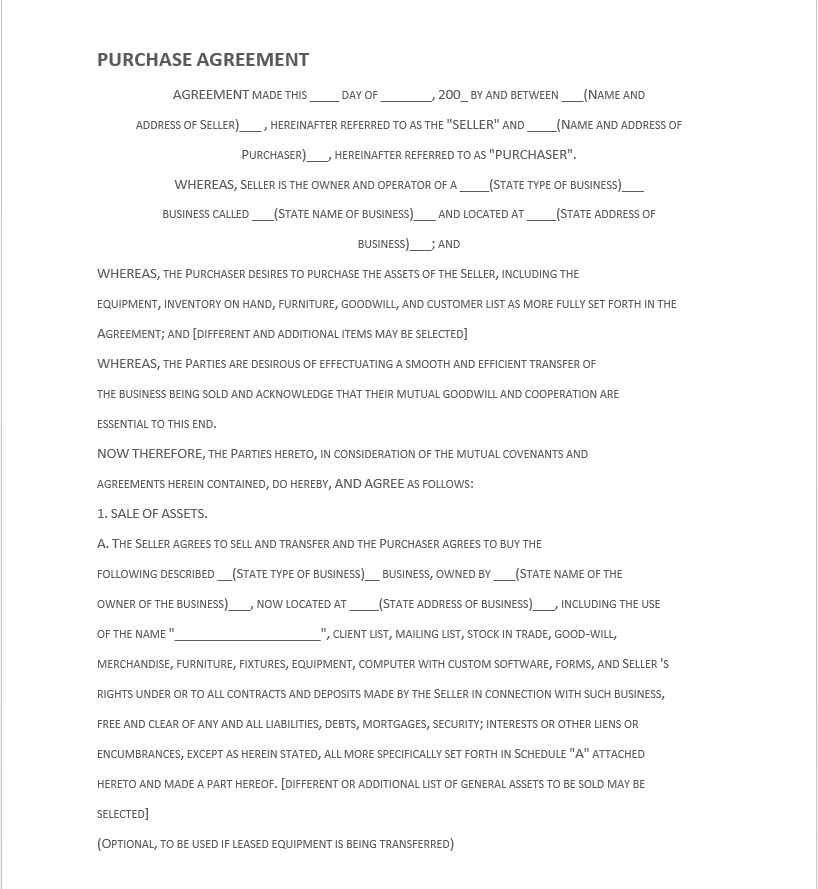Free Simple Purchase Agreement Template Word – A purchase agreement is a lawful document that stipulates the terms and conditions of trade between a merchant and a customer. This document is typically used in goods, assistance, or property sales transactions. It serves as a comprehensive guide for the transaction, providing explicit instructions on how the sale should be executed and how to handle various circumstances that may arise.
The significance of buying and selling transactions cannot be overstated. It safeguards the interests of both parties involved, ensuring that the buyer and the seller are fully aware of their respective rights and responsibilities. It meticulously details the transaction, such as the item being sold, the purchase price, the terms of payment, and any guarantees that may apply.
By establishing clear expectations and delivering a history of the agreed-upon terms, a purchase agreement aids in preventing misunderstandings and disputes, thereby facilitating a smoother and more efficient transaction. It is always advisable to seek the counsel of a legal professional when drafting a purchase agreement. It confirms that all details of goods are adequately covered and that the agreement complies with all relevant laws and regulations.
What is a purchase agreement?
It is basically a letter made by the seller and buyer to explain the rights and obligations of both parties. For example, you can make a purchase template on the process of buying and selling land. In this case, the seller is obliged to surrender the item being sold to the buyer and is entitled to the money worth of the land. Vice versa, the buyer is obliged to pay the item for a certain amount of money and has the right to get it to be traded.
After the signing of the sale and purchase agreement, then both the buyer and the seller are bound to carry out the rights and obligations of each party in accordance with the items of the agreement contained in the agreement.
What are the benefits of a purchase agreement?
It is a legal necessity in many transactions and offers numerous benefits to buyers and sellers. Here are some of the key advantages:
- Clear Terms and Conditions: It provides a clear and detailed outline of the terms and conditions of the sale. It includes the price, quantity, quality, and description of the goods or property sold, each party’s responsibilities, and the delivery and payment timeline. This clarity helps to prevent misunderstandings and disputes.
- Legal Protection: It is a legally binding document protecting both parties. If one party fails to fulfill its obligations, the other party can use the agreement as a basis for legal recourse.
- Risk Mitigation: It can help mitigate risks associated with the transaction. It can include provisions for handling potential issues such as late payment, non-delivery, or damage to goods.
- Evidence of the Transaction: It serves as a written record of the transaction, providing evidence of the terms agreed upon and the exchange. It can be particularly useful in case of future disputes or for tax and accounting purposes.
- Peace of Mind: It provides peace of mind for both buyers and sellers. Buyers can be assured that they will receive the goods or property as agreed, and sellers can be confident that they will receive payment as outlined in the agreement.
- Flexibility: It can be customized to suit the specific needs and circumstances of the transaction. It can include specific conditions, contingencies, or clauses as required.
It provides clarity, legal protection, risk mitigation, and peace of mind, making it essential to any significant buying or selling transaction.
How to make a good purchase agreement ?
Here’s a step-by-step guide on how to write It:
- Identify the Parties: Determine the buyer and the seller interested in the transaction. Contain full names and contact details for both parties.
- Describe the item (s) Being Sold: Provide a clear description of the item being sold. It could be a physical product, real estate, a business, or any other type of asset. Include as much detail as possible to avoid confusion or disputes later.
- Specify the Buy Price: Clearly state the agreed-upon buy cost. Contain those details if any requirements, such as inspections or appraisals, could affect the final price.
- Outline the Payment Terms: Detail how and when the buyer will pay the buy cost. It could be a lump sum amount, installments, or any other arrangement agreed upon by the parties.
- Include Any Contingencies: If the sale is contingent on certain conditions, such as the buyer securing financing or the item passing an inspection, the agreement should clearly outline those conditions.
- Detail the Delivery Terms: Determine when and how the item will be delivered to the buyer. If the seller is responsible for shipping, include those details.
- Discuss Warranties or Guarantees: Include those details if the item is guaranteed. If the item is being sold “as is,” that should be clearly stated.
- Include a Governing Law Clause: This clause specifies which state’s laws will govern the agreement. It is especially important for transactions that cross state lines.
- Signatures: Both the buyer and seller should sign and date the agreement. It makes the agreement legally binding.
It’s also important to keep a copy of the agreement for your records.
The Important of a purchase agreement
It helps as a lawfully crucial document between the customer and vendor, outlining the requirements of the sale. Here’s why it is so important:
- Protection for Both Parties: It covers the client and vendor by clearly explaining the transaction terms. For the customer, it provides they accept what they are spending for, and for the vendor, it confirms they accept the agreed-upon payment.
- Clarity and Certainty: Provides clarity and certainty to both parties. It describes the details of the transaction, such as the definition of the interests or property, the deal cost, the price terms, and the delivery date. This clarity helps to control misconceptions that could lead to disputes.
- Legal Recourse: The other party has a legal alternative if either player fails to meet their responsibilities under the contract. For example, if the seller fails to deliver the goods or the buyer fails to make payment, the aggrieved party can take legal action to enforce the agreement.
- Risk Management: A purchase agreement helps handle risk in a transaction. It can include provisions for what happens if the interests are harmed or lost before delivery or if the buyer fails to make payment on time. These provisions help to mitigate the risks associated with the dealing.
- Regulatory Compliance: In some cases, It is needed by law. For example, dealing with real estate or vehicles requires a written agreement to comply with state laws.
Therefore, it’s always advisable to draft a complete purchase agreement for any significant transaction and to seek legal advice to ensure the agreement is legally sound and adequately protects your interests.
Free Simple Purchase Agreement Template Word
Business Purchase Agreement Template
Used when one party plans to purchase a business from another. It outlines the terms, including the purchase price, the investment in the deal, and the ending date.
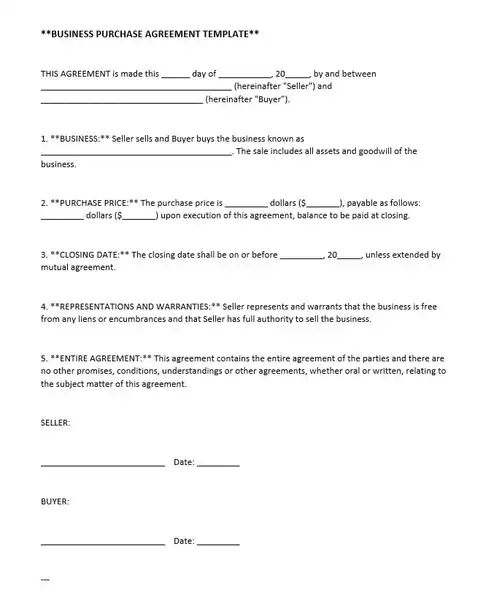
Equipment Purchase Agreement Template
Used when an individual or a business plans to buy tools from another party. It includes the description of the tools, the buy cost, and the delivery date.
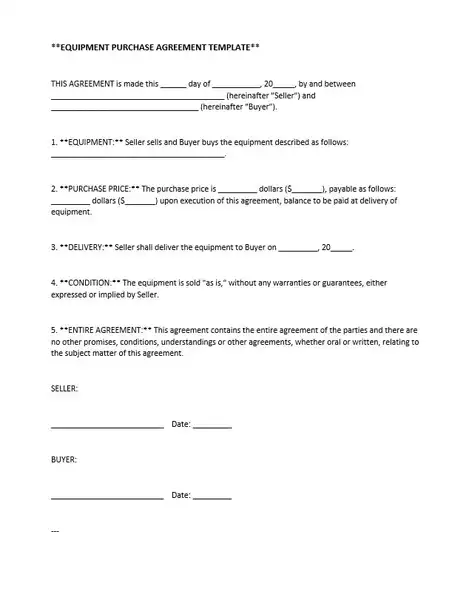
Furniture Purchase Agreement
used when one party plans to purchase furniture from another.
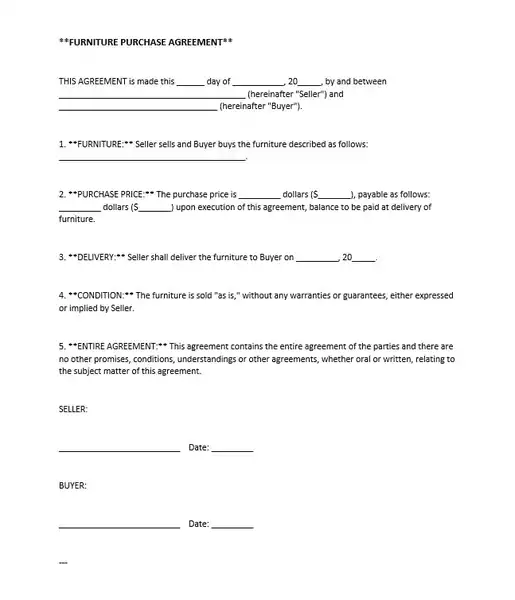
Goods Purchase Agreement Template
Developed for the dealing of interests. It includes sections that document the definition of the goods, the approved acquisition cost, and the delivery date.
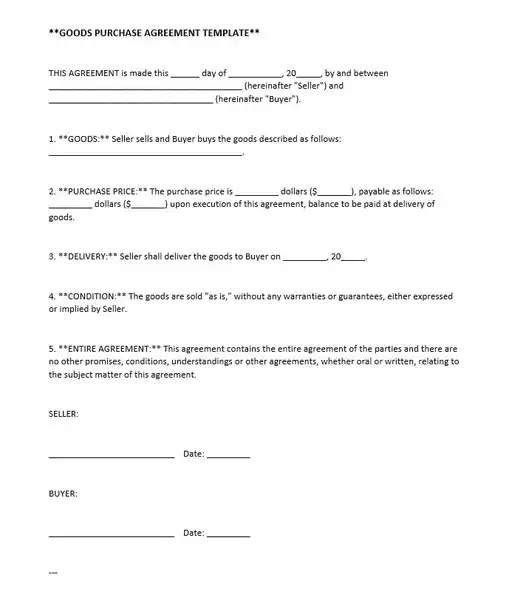
International Purchasing Agreement
Used in international trade when one party in one country agrees to purchase goods or services from another party in another country.
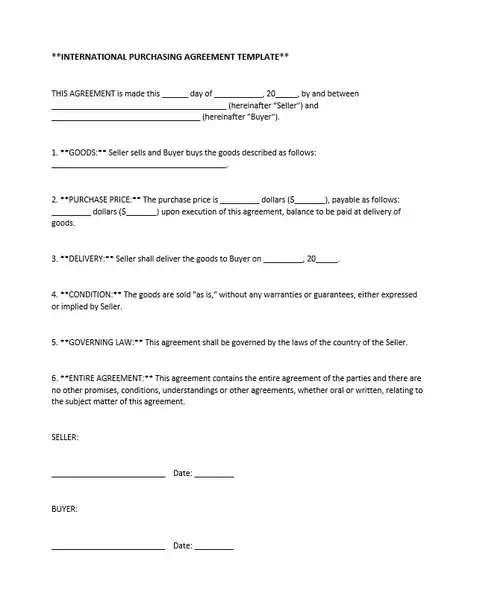
Purchase Agreement for House
Used in-house transactions to outline the terms and conditions of the sale of a house. It contains the buy cost, ending date, and contingencies.
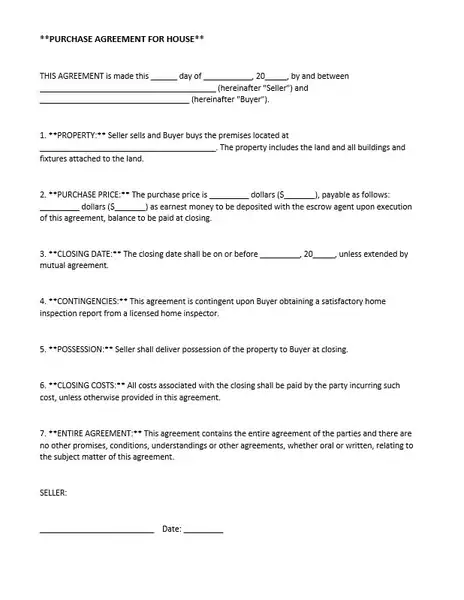
Purchase Agreement Michigan
It is a specific type of real estate purchase agreement used in Michigan. It complies with Michigan’s specific laws and regulations related to real estate transactions.
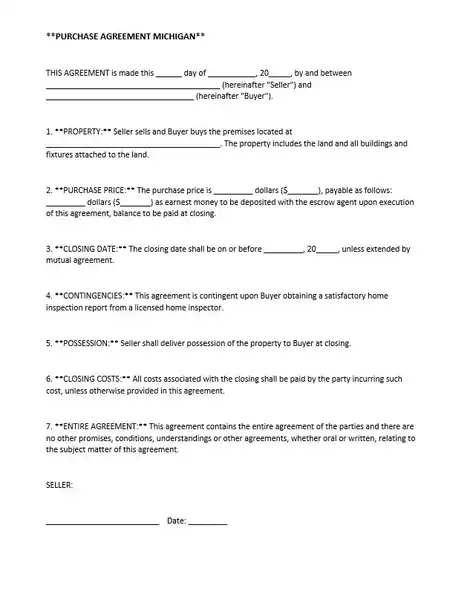
Real Estate Purchase Agreement Template
It encompasses areas that represent the definition of the property, the agreed buy price, the finish date, and any potential contingencies.
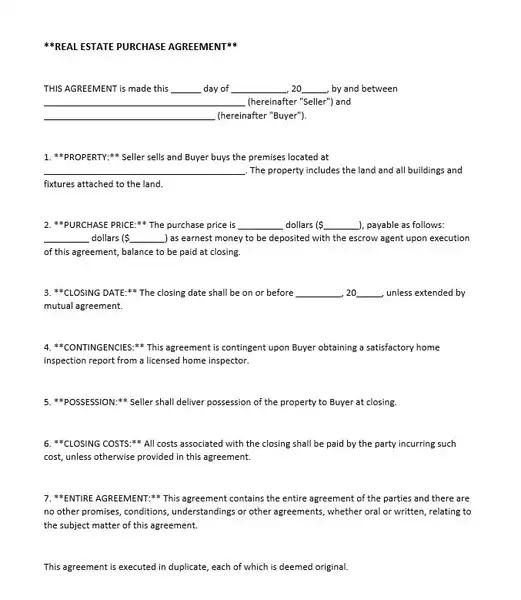
Simple Buy Sell Agreement Form
used when one party plans to buy an item and another plans to sell it.
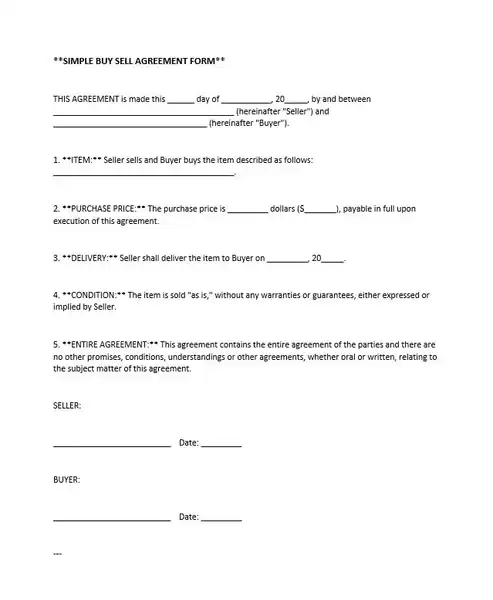
Vehicle Purchase Agreement Template
Prepared for buying or selling vehicles. It incorporates sections that outline the specifics of the car, the set buy price, and the delivery date.
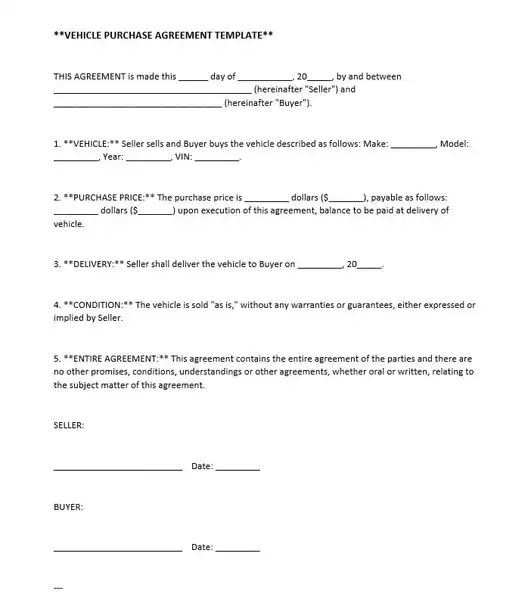
These templates serve as a simplified method for preparing a purchase agreement. However, they should be tailored to suit your specific requirements, and it’s recommended to have them checked by a legal expert for thoroughness and accuracy.
Elements of a purchase agreement
These elements provide that both parties clearly explain and understand all aspects of the trade. Here are the essential elements:
- Names of the Parties: Display the names of the customer and the vendor. It establishes who is lawfully secured by the duration of the contract.
- Description of the Item Being Sold: Include a clear explanation of the Itemsold item or property. It can include physical characteristics, model numbers, or other identifying features. In the case of real estate, this would have the address and lawful description.
- Purchase Price: It includes the total amount to be paid and the currency for the payment.
- Payment Terms include when the payment is due, acceptable forms, and applicable financing terms.
- Delivery Details: The contract should define the delivery details, including when and where the item will be provided.
- Warranties or Guarantees: If any warranties or guarantees are contained in the sale, these should be detailed in the contract. It contains what is covered, the duration of the warranty, and any actions that could void the warranty.
- Contingencies: It must be completed before the deal can be finalized. It could include the customer guaranteeing financing, the item passing an inspection, or the seller finding a new home.
- Signatures: For the contract to be lawfully binding, it must be signed by both the customer and the vendor.
Including these key elements can provide a clear framework for the dealing, prevent misinterpretations, and defend the goods of both parties.
Legal Aspects of a Purchase Agreement
Here are some key legal aspects to consider:
- Written and Signed: It must be on paper and signed by both parties. It provides a clear document of the agreed-upon times and helps prevent disputes.
- Legally Competent Parties: Both parties interested in the contract must be legally competent. It implies they must be of lawful age to comprehend the contract’s terms and implications.
- Lawful Purpose: The contract must be for a lawful purpose. In other terms, the item or property being sold must be permitted to sell, and the terms of the contract must not violate any rules.
- Consideration: generally, the item or property being sold and the money being paid.
- Mutual Consent: It may not be enforceable if a party is coerced or misled into entering the agreement.
Common Mistakes to Avoid When Drafting a Purchase Agreement:
- Not Clearly Defining the Parties Involved: It’s crucial to define who the buyer and seller agree with clearly. It includes full names and contact information. If the parties are not correctly identified, it can lead to legal complications.
- Not Specifying the Purchase Price: The agreement should clearly state the purchase price. If it’s not, disputes could arise later.
- Not Including a Detailed Description of the Goods or Property: The agreement should include a detailed description of the goods or property sold. It includes size, color, model, condition, and other relevant details.
- Not Specifying Payment Terms: The agreement should clearly outline the payment terms, including the amount, due date, and payment method.
- Not Including Warranties or Guarantees: If the seller provides any warranties or guarantees, these should be clearly stated in the agreement.
- Not Including a Dispute Resolution Clause: It’s important to include a clause that outlines how disputes will be handled. It can help avoid costly and time-consuming litigation.
- Not Having the Agreement Reviewed by a Lawyer: Even if you’re using a template, it’s always a good idea to have the agreement reviewed by a lawyer to ensure it’s legally sound.
Tips for Drafting a Purchase Agreement
It can be a complex task, but here are tips to help you create an effective agreement:
- Be Clear and Specific: The contract should summarize all the sale times. Be as specific as possible to avoid misconceptions.
- Address All Potential Issues: Think about potential issues that could arise and address them in the agreement. It could include what happens if the item is damaged before delivery or if the buyer fails to make payment on time.
- Seek Legal Advice: It’s always a suitable idea when drafting a contract. A lawyer can help provide a legally sound, comprehensive deal that covers your interests.
- Use Plain Language: While it’s vital to be thorough, try to use plain language whenever possible. It can create an arrangement that is easier to comprehend for all parties involved.
- Review and Revise: Take your time with the process. Take the time to check and revise the contract as necessary. Make sure all parties comprehend and agree to the terms before signing.
By keeping these legal aspects and tips in mind, you can draft that is legally sound and clearly outlines the terms of the sale.
FAQs
What is a ‘triggering event’ in a Purchase Agreement?
A typical event or event activates certain provisions in the agreement. For example, a triggering event in real estate could be the customer ensuring financing.
Do I need a lawyer to draft a Purchase Agreement?
While having a lawyer draft is not mandatory, it’s highly recommended. A lawyer can guarantee that the contract is legally sound and that your interests are protected.
What happens if a Purchase Agreement is breached?
The injured party may be allowed certain remedies, such as injuries or detailed performance. The exact remedies rely on the contract’s terms and the breach’s nature.
Can a Purchase Agreement be canceled?
It can be canceled relying on the terms of the contract. Some agreements authorize cancellation under certain conditions, while others do not.

The content creator team at calipsotree.com is dedicated to making topics accessible to everyone, with over 9 years of experience in writing and breaking down complex concepts into easy-to-understand articles that answer readers’ financial questions.






